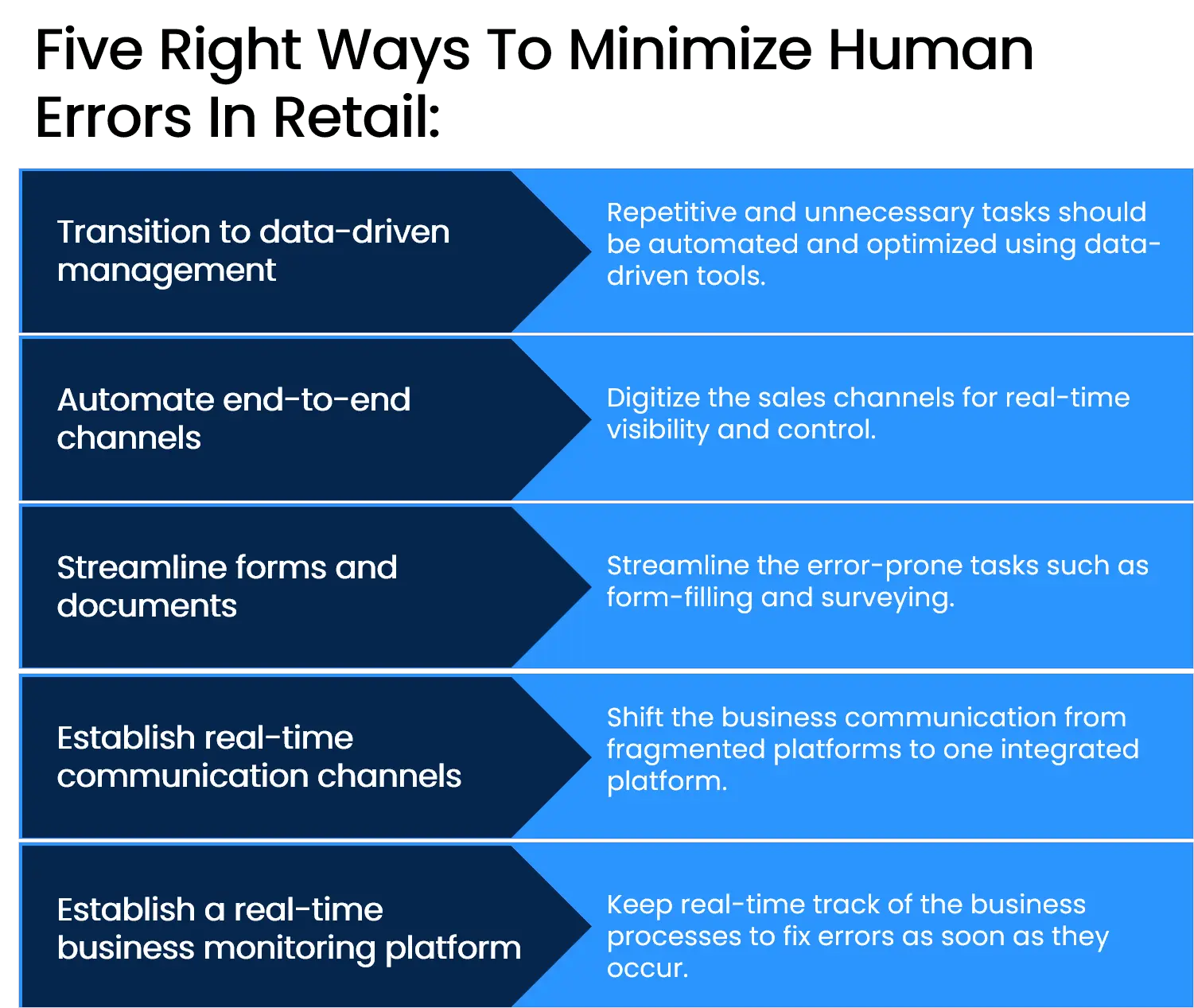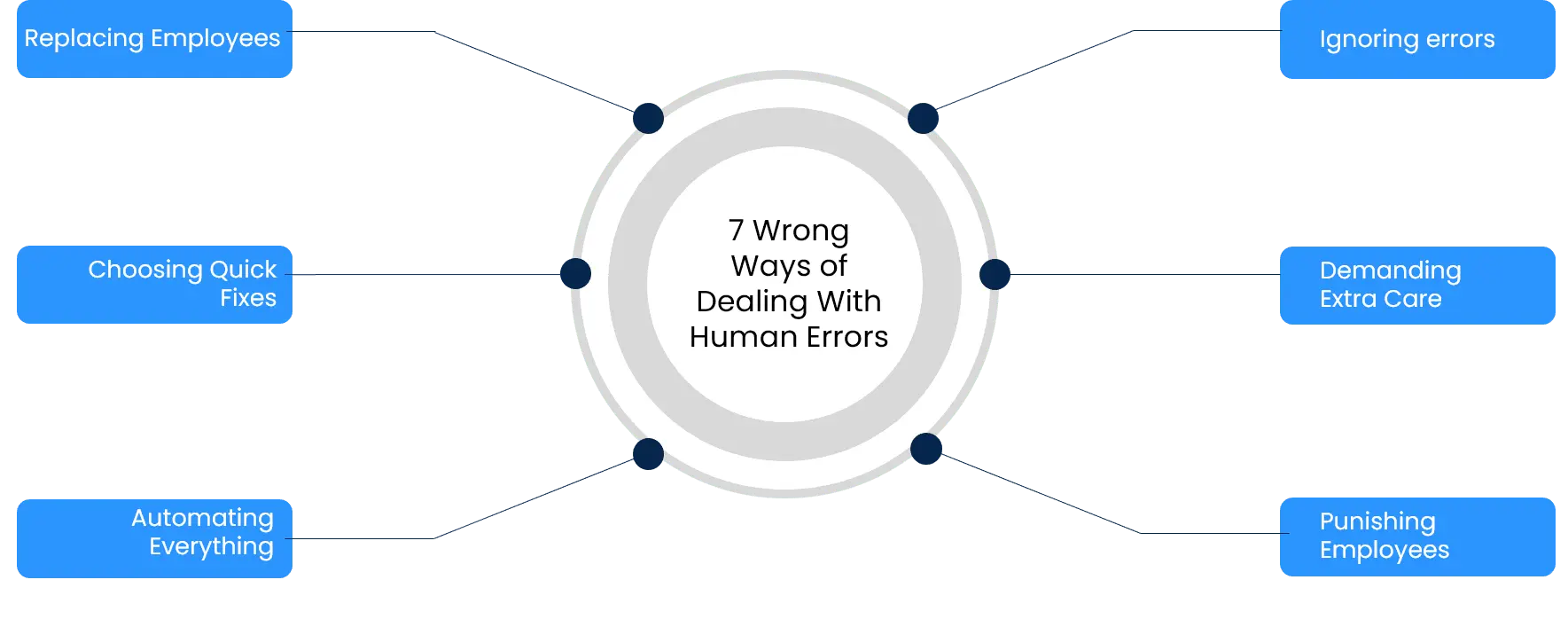Quick Summary
- Errors are everywhere. They make management harder and less productive.
- Human errors can be categorized under six broad categories: slip errors, rule-based errors, knowledge-based errors, decision-based errors, and communication errors.
- Companies often ignore these errors or punish the employees who cause them. These are wrong ways that cause more harm than good.
- To minimize these errors, companies must follow the five proven ways that eliminate these errors from the roots.
- Above that, technologies like Sales Force Automation can drastically reduce retail sales and distribution errors.
To err is human; to forgive is divine. We all have heard this proverb someday or another, but is forgiving errors a good idea for a business? Isn’t neglecting errors the surest way to drive your company toward failure? Can businesses (especially retail businesses) even dare to do so?
Forgiving may be divine, but error-solving is what carries a business forward. This blog discusses the challenges that retail and consumer goods companies face due to human errors and discovers proven ways to fix them.
Types of Human Errors

Slip errors
These errors occur when an employee, manager, or sales rep makes an unintentional mistake due to a habit or routine. For example, filling in wrong data entries, scanning wrong items, and transposing files.
Rule-based errors
Rule-based errors are the ones that occur because of the selection of wrong rules. It includes errors in which an employee follows a standard procedure incorrectly, such as entering the wrong code or form.
Knowledge-based errors
When an employee or rep lacks the necessary knowledge to perform a task correctly, they occur a knowledge-based error. For example, when a sales rep does not know typing, he is prone to make errors while inserting into spreadsheets.
Decision-based errors
Decision-based errors occur when an employee or a sales rep makes an incorrect decision based on his limited knowledge and the heat of the situation. This includes errors such as not offering customers a certain product or service when needed.
Communication errors
Communication errors happen due to some breakdown in communication among employees or between employees and customers. It greatly hinders the ability of teams to coordinate and perform in sync. Some common communication errors are: choosing wrong beat plans and misinterpreting the management instructions.
7 Wrong Ways of Dealing With Human Errors
Although human errors are universal and arise everywhere, most companies deal with them incorrectly. They either ignore these errors or punish the employees who commit them. Result? Reduced employee morale while the talent persists.
Here are the X most common wrong ways that companies use to minimize their errors:
- Ignoring or denying the existence of errors
- Asking employees to take extra care
- Punishing Employees for errors
- Hiring “smarter” people
- Implementing quick fixes without addressing the root causes
- Focusing Solely on Automation
The Right Ways To Reduce Errors In Retail:
Here are the 5 proven ways to fix these human errors from their roots:

Automate end-to-end channels:
Many tasks in retail need repeated execution. According to Mckinsey, more than 30% of sales tasks can be automated.
By simply analyzing the field sales, we can spot tasks like data entry, beat planning, and paperwork done daily by reps. These tasks do not require any human expertise or intelligence to be done perfectly.
They are simply the same set of actions done repeatedly. Take, for example, data entry — where all you need to do is fill order data from paper notebooks into a spreadsheet.
Yet, it leads companies toward thousands of data errors causing enormous trouble every month.
Why does it happen? It happens because humans are not perfect at performing repeated actions. Machines are. Therefore, all the repetitive tasks should be automated with tools to ensure minimum error.
Transition to data-driven management
Human beings have limited senses. Our perception is distorted and knowledge limited. It doesn’t matter how good a manager is. He cannot oversee his entire territory, see employee status, manage absences, and track collections simultaneously.
This limited pool of visibility leads businesses to bad decisions and even bigger losses.
There are many stories about companies whose leaders thought things were going well but ended up in rags. Why so? What causes these management errors? They happen because humans have limited senses and knowledge.
To fix that, businesses are transforming their traditional management into a data-driven one where the primary driver of decision is real-time data, not feelings.
Streamline forms and documents
Among all the human errors in retail, most occur due to outdated tools such as order-taking notebooks. They jam the fundamentals of business data, including daily orders collected, surveys, and manual order summaries made by managers.
These inefficiencies cause a domino effect and influence larger errors with time. The district sales summary is automatically erred when an area sales summary is erred. And with the district summary erred the state summary blunders.
To fix them, companies must streamline their data collection, organization, and processing tasks in an automated system GrowmaxBI. GrowmaxBI centralizes the data storage and streamlines the process eliminating all the possibilities of data errors.
Establish real-time communication channels
Bad communication plays a major role in triggering errors in the retail distribution processes. Once the employees enter the fields, managers have no direct way of communicating tasks. All they can do is call the individual reps.
This is a challenge. Phone calls are non-visual, they consume time, and they come with their own set of limitations that makes them ineffective team-management tools.
Therefore, companies should establish proper communication channels to interact with their employees in real time.
Establish a real-time business monitoring platform
Why does eCommerce always have a competitive edge over retail?
If we see it from a business point of view, e-commerce offers sellers a wide range of real-time insights. It lets you see your orders, customers, trends, demographics, and other insights.
Using such insights, the sellers optimize themselves, their products, and their marketing campaigns for maximum productivity. Doing so is not possible in traditional retail. Managers cannot monitor their sales territories or find inconsistencies before it is too late.
Therefore, retail companies should establish real-time business monitoring systems. For example, GrowmaxBI digitizes the entire sales channels of the companies and visualizes them in interactive real-time dashboards.
Explore more about Sales Force Automation here.





